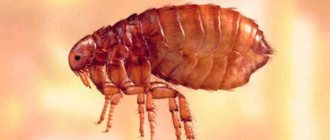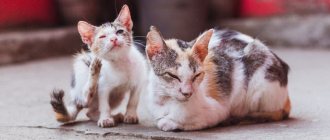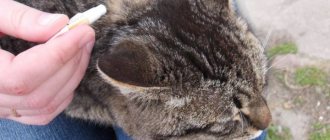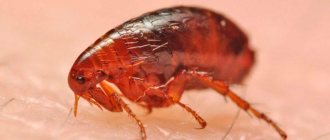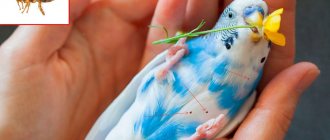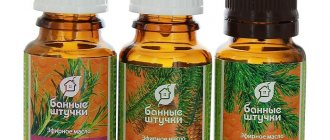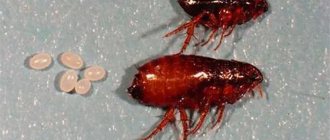Kittens, compared to adult cats, are more often attacked by various parasites.
Moreover, fleas are considered the most common among them. They cannot be removed from kittens using the usual means for adults. Their sensitive immune system will suffer greatly from such harsh exposure.
You can remove fleas from a kitten without harming it using various veterinary remedies, widely available in pet stores and veterinary pharmacies, as well as using folk remedies.
How can you tell if a kitten has fleas?
On the one hand, it is more difficult to suspect fleas in a very small kitten than in an adult pet. After all, the baby has not yet developed the habit of regularly licking, scratching, and gnawing its fur, and we cannot notice changes in this ritual. On the other hand, the kitten is small, its character has not yet been formed, and we can easily examine it for fleas. Particular attention should be paid to the area:
- behind the ears;
- fur under the neck;
- at the base of the tail;
- between the hind legs (in the groin).
By examining these areas, you can detect adult parasites, their eggs (small light-colored grains) or flea excrement (small dark-colored grains).
You can detect fleas in older kittens who are already learning or know how to look after themselves by observing their behavior. If baby:
- itches too often and furiously;
- suddenly begins to chew out its fur;
- sleeps restlessly and wakes up to scratch;
then most likely your pet needs flea treatment for kittens. A simple home test will help you finally verify this:
- place the baby on a white surface (sheet of paper, fabric, etc.);
- carefully comb his fur;
- We remove the kitten from the white surface and examine it.
Having noticed dark, small crumbs on the surface, drip plain water onto them. If, after contact with the liquid, reddish-brown stains form around the crumbs, then we are dealing with flea excrement and the pet really has fleas.
The above methods will help to detect parasites in a timely manner and take adequate measures. In later stages of the disease, when the kitten already has a lot of fleas, characteristic symptoms and changes in behavior will help to recognize them.
- The presence of scratches and crusts on the baby’s body.
- Redness, wounds, signs of allergic rashes on the skin.
- Low quality wool - lack of shine, glued hairs, bald patches, etc.
- Poor appetite or its complete absence.
- Weight loss.
- Restless behavior and/or plaintive meowing for no apparent reason.
At the same time, very young kittens can noticeably weaken, and older pets can show aggression. As a rule, at this stage of the disease it is no longer possible to do without the help of a veterinarian. A specialist will examine the baby, study his condition, tell you how to treat a kitten for fleas, how to care for him and improve his health.
Treatment of insect bites
Many children (and some adults) have pronounced local reactions to the bites of midges (mosquitoes, midges, horseflies): immediately after the bite, a urticarial element forms around it within a radius of 1–3 cm (as in urticaria, intradermal edema), lasts for several hours and itches intensely. Then it turns into a papule, which is smaller in size but more persistent. On top of this papule there are often scratches and bloody or serous crusts. The papule usually goes away within a few days, but the crusts can remain for a very long time - if a person scratches them with his nails several times a day, rips them off, and they form again. The use of external or systemic medications after insect bites reduces the likelihood of serious scratching, secondary infection, reduces unpleasant symptoms (itching, swelling at the bite site, burning and hyperemia) and speeds up recovery. This is especially important for children, who are prone to more violent local reactions and are much less able to restrain the urge to scratch the bite site until a bloody scab appears.
Immediately after the bite
As soon as you find urticarial marks on your child’s skin from fresh bites (you came home from the street or picked up a woken up baby in your arms), apply a cooling antipruritic mash (Calamin or Tsindol) to the bite sites. Repeat application once an hour on this day, most likely in a day you will hardly be able to find the bite site (all changes on the skin will disappear).
If the urticarial element nevertheless turns into a papule or crust
If you did not apply the mash, or did, but a papule still forms and itches, start applying a low-potency steroid cream (hydrocortisone eye ointment, Sinaflan or Afloderm) to the area. The steroid is applied 1–2 times a day; a volume of ointment of no more than half a grain of rice is required for one element of the rash. The course usually takes 2–4 days, during which time the element will almost completely disappear. For severe itching or local swelling, you can use a second-generation antihistamine, such as Zodak (as directed) for several days in a row.
If a midge has bitten near the eye or on the lip, and swelling of frightening proportions has developed
In this case, the child’s eyes may stop opening, and problems with pronouncing words may appear (a swollen lip makes it difficult to speak clearly). Most often, it is enough to just wait, or apply cold and wait - and after 15-30 minutes such local swelling begins to subside, and after an hour it disappears completely. In severe cases, or if you want to speed up recovery, you can (in addition to cold) use an antihistamine internally and a local steroid externally.
If bitten by a Hymenoptera (wasp, bee, bumblebee, hornet, etc.)
The bite or sting of Hymenoptera is much more unpleasant and dangerous than the bites of ordinary midges. They cause severe pain, a strong local reaction (redness, itching, swelling) and take much longer to resolve. With multiple bites, in addition to local reactions, there may be severe systemic reactions (malaise, fever, weakness, loss of appetite), which disappear within a few days. Additionally, some people are allergic to Hymenoptera venom and may develop anaphylactic reactions and even die from such stings. Help for single bites in the absence of anaphylaxis (fainting or semi-fainting, a pronounced change in general well-being) is generally no different from help for a midge bite, but the effect will have to wait much longer. If severe systemic reactions occur, you must immediately consult a doctor, and if anaphylaxis and/or Quincke's edema occurs in the larynx (hoarseness and severe difficulty breathing), call an ambulance immediately. For a person who has experienced anaphylaxis at least once in their life, the doctor will write a prescription for epinephrine (ideally an epinephrine pen) and teach him and his loved ones how to use this drug while waiting for an ambulance.
Important: when stung by a bee, you need to remove the sting from the wound as quickly as possible; assistance begins with this step.
A common complication of insect bites: papular urticaria
Papular urticaria is a rash that occurs in response to insect bites in places where the insect has not bitten; this is a “slow allergy” to bites. Most often it occurs in response to bites from fleas (including fleas), ticks and scabies, but a simple gnat can also lead to it. Papular urticaria is not dangerous, but can be uncomfortable, itchy, cosmetically unsightly and last for several months. It will go away on its own sooner or later, but a long course of antihistamines and sometimes local treatment can be useful to relieve symptoms and speed up recovery. You can read more here.
General Tips
Try not to let your child scratch the bite area, especially the eyes. This gives immediate relief, but leads to scratching, infection, and significantly lengthens the recovery time.
Author:
Butriy Sergey Alexandrovich pediatrician
How to remove fleas from a kitten?
Veterinary pharmacies offer a huge selection of anti-flea products. But the problem is that in most cases their composition and method of application are suitable exclusively for adult cats. This problem is especially acute for owners of two categories:
- when a very tiny baby lives in the house, who is barely 1 month old, and standard flea treatment for kittens can harm his body;
- when a pet lives in the house and is also looked after by a cat, which means any anti-flea agent will be licked off its fur by a caring mother.
In the first case, improvised and folk remedies will come to the rescue, and in the second, for the treatment to be effective, the kitten will have to be separated from the mother cat for a certain time. But first things first.
Who are fleas and why are they dangerous for dogs?
Fleas are small, dark-colored insects with a yellow belly and a flattened body up to 4 mm in size. They have a hard shell, long limbs with bristles pointing backwards. Thanks to this structure, insects move along the fur of pets and jump far. They reproduce by laying larvae on the skin and fur. Parasites live for at least three years.
The main danger lies in the flea’s ability to bite the pet’s skin, which causes saliva to penetrate the wound and lead to the following pathologies:
- Intense itching in the bite area, redness of the skin.
- Scratching on the affected areas, causing skin ailments.
- Excessive hair loss.
- Viruses.
- Infection with helminths.
- Penetration of bacteria into wounds leading to allergies.
- Anemia with risk of death.
An insect that passes from an infected animal to a healthy one quickly multiplies and drinks the dog's blood. Typically, the increase in numbers occurs in autumn or spring. They are very dangerous for pets, so the owner needs to know what fleas look like and how to remove them.
Fleas are practically not transmitted to humans from dogs. Insects can bite the owner, but due to the lack of fur, they will not be able to remain unnoticed for long. But there is a potential danger.
How to remove fleas from kittens up to 1 month old
The fight against parasites at such a young age comes down to following the following recommendations.
- Daily change (washing) of the kitten's bedding.
- Daily, very careful combing of the baby with a fine comb dipped in water with freshly squeezed lemon juice: from the top of the head to the scruff of the neck to the back to the tail, and from the neck to the belly to the hind legs.
If these measures do not give a positive result, then you should seek help from a veterinarian, who will recommend a safe flea remedy for 1-month-old kittens. Self-medication at this age is strictly prohibited!
One way to protect a kitten under 6 weeks of age from fleas is to treat the cat's mother with drops with an "umbrella effect", such as Stronghold. It rids the adult cat and its habitat of parasites, thereby indirectly protecting nearby kittens from these parasites.
Flea control rules - precautions
To quickly remove fleas, you must follow these rules:
- Act immediately. A distinctive feature of fleas is their rapid reproduction; if there are signs of infection, it is necessary to provide assistance on the same day. Also, the more parasites are present, the more difficult it is to get rid of them.
If you cannot recognize fleas on your own, it is better to consult a veterinarian to confirm the suspicion of parasite infestation. They can sometimes be easily confused with other canine problems, such as skin conditions.
- Choose the right product. Medicines sold in veterinary pharmacies are suitable for different breeds. To effectively cope with parasites, you need to choose a product that is suitable for the specific breed, coat type, and age of the pet. It is best to contact your veterinarian for a prescription.
- Follow the instructions. Most drugs in different dosage forms are indicated for use several times. If you use the product only once and neglect the next use, the parasites may return.
It is also important to observe safety precautions when using the chosen product. The tablets should be given to your pet according to the instructions. Shampoo and other products for application to the coat must be used strictly with gloves.
An infected pet must be isolated from other pets. If he lives at home, it is necessary to allocate a separate room for him, if on the street, do not let him out of the enclosure. You also need to protect your dog from contact with children, since fleas are carriers of many infections.
How to get rid of fleas on a 1 month old kitten
Daily brushing does not lose its relevance for slightly older children. Starting from 1 month, they can already be bathed using anti-flea shampoo:
- the product is diluted with water;
- Gently distribute over the fur until light foaming occurs;
- after a few minutes (the time must be clarified in the recommendations of the shampoo manufacturer), the foam is thoroughly rinsed off;
- The kitten's fur is dried and carefully combed out.
During bathing, you need to make sure that water and the product do not get into your baby’s ears, nose and mouth. To choose the right safe flea shampoo for kittens over 1 month old, it is recommended to consult a veterinarian. And if the pet is already 1.5 months old, does not show signs of weakness and can be painlessly separated from the mother cat for a couple of hours, then the specialist will recommend drops on the withers against parasites (for example, Stronghold).
Flea collars
The easiest way to remove fleas is with a special collar. This is a great option for cats who “walk on their own” and do not spend much time at home. Kittens can wear such collars only from 3-4 months - the concentration of insecticides in such “accessories” is extremely high , and a small kitten can simply be poisoned. The instructions for use are very simple: the collar is put on the animal and pressed tightly against the body so that the effect of the active drug on it begins. In case of long-term refusal to wear the collar, it is better to pack it in a bag so that the insecticide does not erode.
© shutterstock
No collar, however, provides absolute protection against fleas, so this method of treatment is best used as an aid to the main one - together with shampoos and sprays. The service life of the product is from one to seven months.
Collar brands:
- "Hartz". The standard among flea collar brands. It is waterproof, allowing it to be used in almost any weather. Depending on the weight and size of the cat, you can choose a special model, but this product can only be used to remove parasites from kittens from 3 months.
- "Beaphar." The only one of all the collars that, if desired, can be put on a kitten at the age of 1.5 months. It's all about the active component - a natural insecticide is used in the manufacture of this product, which makes collars of this brand practically harmless to cats.
- "Bolfo". Collars of this brand, like products of the Hartz brand, are also divided depending on the weight of the animal and have water-repellent properties. Service life – 4 months.
- "Leopard". The absence of side effects and low cost in comparison with other brands distinguish the collars of this company. Perfect for domestic cats.
- "Doctor Zoo" Similar to the previous company. It is distinguished by extremely rare statements about the occurrence of allergic reactions. Service life – 2 months.
How to remove fleas from a 3 month old kitten
To combat blood-sucking parasites at the age of three months (after weaning from the mother cat), you can use drops on the withers or a special flea spray.
- Drops on the withers are easy to use: they are applied by spreading the fur directly onto the pet’s skin. The insecticides they contain (substances harmful to parasites) will gradually be distributed throughout the baby’s entire body, ensuring the death of fleas and long-term protection from re-infection. And if you use systemic drops, such as Stronghold, then the kitten will be treated not only for external parasites, but also for round helminths.
- A special spray is a fast-acting flea remedy for kittens 3 months old. It is distributed throughout the pet’s body against the growth of fur. It is very important that the spray not only gets on the skin, but also slightly moisturizes the baby. After using the spray, the kitten’s behavior needs to be monitored: make sure that it does not lick its fur.
Before using drops on the withers and flea spray, it is also recommended to consult with the veterinarian who is monitoring the kitten.
What complications does the disease cause?
When the parasite attaches to the intestinal wall, it secretes a harmful secretion and damages the mucous membrane. In the latter case, poorly healing ulcers form and hemorrhages occur. If tissues are deeply damaged, inflamed granulomas appear. They consist of abnormally overgrown cells, lymph and blood. Due to the fact that pinworms injure the intestines, children experience abdominal pain. The microflora is disrupted and dysbacteriosis occurs.
When the female crawls out, she damages the soft tissue. The perianal area is irritated by the secretion of the worm - abrasions, cracks, eczematous rash, and neurodermatitis appear. If the helminth penetrates the genitals of girls, endometritis and other gynecological diseases may develop.
In the presence of pinworms the acidity of the stomach decreases , food is digested worse, and the course of intestinal diseases becomes more complicated . Parasites reduce immunity, because of them the effectiveness of vaccinations decreases and the number of side effects from them increases. Medicine knows of cases where pinworms pierced the rectum and entered the abdominal cavity, followed by peritonitis.
Being in the organs of the gastrointestinal tract, parasites cause the following complications:
- inflammation of the pelvis and peritoneum;
- acute skin lesions in the perirectal area;
- stagnation of feces in the cecum;
- pyoderma;
- anemia;
- developmental delay of the child;
- disturbance of appetite and sleep; Source: R.A. Fayzullina, E.A. Samorodnova, V.M. Dobrokvashina Helminth infections in childhood // Practical Medicine, 3(42) May 2010.
- in girls – cystitis, vulvitis;
- in boys - enuresis;
- anal fissures.
Universal flea remedy for kittens
The modern pace of life dictates its own principles, which also apply to keeping pets. Submitting to them, not every person is ready to spend a lot of time and effort fighting parasites. And even the most caring owner wonders how to remove fleas from a kitten quickly, with a guarantee of a positive result and for a long time. Perhaps there is some universal remedy to achieve this goal?
Answering this question, Russian veterinarians confidently recommend the broad-spectrum antiparasitic drug Stronghold. These are drops on the withers that can be applied to kittens starting from 1.5 months (or 6 weeks). During use, the drug demonstrates a number of the following properties:
- Stronghold destroys not only fleas, but also other parasites - lice, lice, scabies mites, roundworms, etc.
- The drug is easy to apply and quickly distributed throughout the pet’s body, providing its therapeutic effect.
- Stronghold drops on the withers destroy blood-sucking parasites and provide reliable protection against re-infection for 1 month.
After applying drops to the withers, the kitten’s behavior does not need to be controlled for fear that it will lick the drug from its fur. And just 2 hours after using the drug, you can already behave with your beloved pet as usual - pick it up, stroke it, play and even bathe it.
When wondering how to rid a kitten of fleas without extra cost and effort, it is important to understand that any, even the most universal and effective remedy, may turn out to be useless without an integrated approach to solving the problem of parasites. To implement it, you will have to follow a number of simple recommendations.
- All animals in the house must undergo antiparasitic treatment at the same time.
- All areas of the apartment or house where pets live must be cleaned, or better yet, disinfested.
- All personal belongings of the pet must be treated with an insecticidal preparation, or better yet, disposed of.
If the question is how to remove fleas from a one-month-old kitten, for whom Stronghold is not yet recommended, then it is better to take care in advance to prevent infection with blood-sucking parasites.
Folk remedies
Some people manage to rid their pet of fleas using folk remedies, but veterinarians categorically do not recommend using this method as the main one. It is better for them to complement the effect of anti-flea drops, tablets, and shampoos. Common home remedies are:
- Garlic. Take a medium-sized head, peel it, grind it using a blender or other method until you obtain a porridge-like consistency. Pour 0.5 liters of water over the garlic and let it brew overnight. Rub the animal's fur with the solution, soak a cotton swab in it, and rinse with running water.
- Onion. We take several medium-sized onions and prepare a solution similar to garlic based on them. The pungent smell of these vegetables, which are poisonous to fleas, repels any parasites.
- Laundry soap. For bathing, you can use not only pharmacy shampoos. Laundry soap is known for its antibacterial, antiseptic, and other beneficial effects. After soaping the wool, it is recommended to leave it for half an hour, then rinse everything off with clean water.
- Essential oils. Can be used independently or added to other products. When bathing, it is useful to add a couple of drops of any strong-smelling oils to the water. You can also drip them onto the animal’s withers.
It is better to combine several oils at once. The most effective of them are lavender, pine needles, mint, eucalyptus, cloves, and tea tree.
- Vinegar. Modern veterinarians are against this remedy, but among the people it continues to be effective. To treat with vinegar, take a glass of 9% food product, dilute it in a liter of water at room temperature, wash the animal with it daily, possibly after using pharmaceutical shampoos.
Using folk remedies as an independent measure to combat fleas usually does not bring the desired result. It is better to combine them with pharmaceutical drugs.
Preventing fleas in kittens
The best prevention against fleas for kittens 1, 2, 3 months and any age is regular antiparasitic treatment of its future mother. For this purpose, you can safely use the same Stronghold. After all, the drug demonstrates a prolonged (long-lasting) effect and will protect the cat from parasites for 1 month. After this period, the treatment should be repeated.
We should not forget that fleas can independently enter an apartment from the entrance, basement and from the grass growing near the house, where they wait for their potential owner. We can also bring adult parasites or their eggs into the house on our shoes. Considering the ways fleas enter your home, it is necessary to keep your hallway clean - the room is regularly wet cleaned, paying special attention to gaps, cracks, joints and other nooks and crannies. And when using a vacuum cleaner, immediately dispose of its contents, immediately after use.
Well, and, of course, one should take into account the fact that the main carriers of parasites are stray animals. Therefore, it is advisable to minimize contact with them. And if a noble decision has been made to take a pet from the street, then first of all you need to solve the problem of how to get rid of fleas from a kitten. Because the fur of the little happiness probably contains ubiquitous, blood-sucking parasites.
Sources and signs of flea infestation
A small kitten suffers from fleas more than an adult animal, so it is important to notice in time when your pet has become infected with them.
Where do fleas come from?
There are several options for the appearance of fleas in a newborn kitten. The baby can become infected from the mother cat or another animal living in the house. If a kitten is the only living creature in the apartment, then there is a possibility that it picked up fleas from its previous owner.
Another very common way is the introduction of larvae or even an adult insect on shoes or clothing. A person, without noticing it, can bring a new tenant into the apartment. After finding favorable conditions, individuals feed on the blood of new hosts, mate and reproduce. After 21 days, the laid larvae develop into adults and their life cycle repeats.
Symptoms of flea infestation
It is possible to determine that a kitten has fleas only after a thorough examination. Signs to look out for:
- scratched wounds appear on the skin;
- On the belly, ears, and muzzle the insects themselves or their black excrement and white eggs attached to the fur with a sticky secretion are visible.
A thorough examination by a veterinarian can help identify fleas in a kitten.
The behavior of the small pet also changes:
- the kitten's sleep becomes restless, it twitches its paws or even jumps;
- the animal does not eat well;
- The baby constantly scratches with his paws or bites certain parts of his body with his teeth.
If your kitten is constantly itching, this may be one of the signs of flea infestation.

